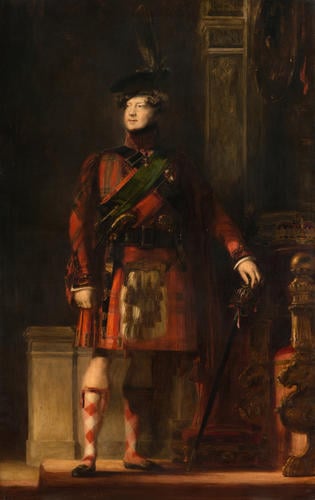-
1 of 253523 objects
George IV (1762-1830) Signed and dated 1829
Oil on canvas | 279.4 x 179.1 cm (support, canvas/panel/stretcher external) | RCIN 401206
-
George IV succeeded his father as King in 1820 and in August 1822 was the first reigning monarch to visit Scotland since Charles II. On 17th August he held his first levée at the Palace of Holyroodhouse when he wore full Highland dress. The success of King George IV's visit was due to the preparations of Sir Walter Scott, the historical novelist, poet and dramatist, who revived Scotland's romantic past in the pageantry of the state visit. He was assisted by David Stewart of Garth, one of the founders of the Celtic Society, who helped devise the King's Highland dress. The King probably intended Sir Henry Raeburn, the King's Limner for Scotland, to record his appearance, but the commission was inherited by the Edinburgh-trained artist David Wilkie, who succeeded him in this appointment after Raeburn's death in 1823. Wilkie had executed a sketch by February 1829 and approval of this was followed by seven sittings from the King. The portrait was exhibited at the Royal Academy in April 1830, two months before the sitter's death.
The King gazes fixedly to the left in a pose of readiness for action, his right hand in a closed fist, his left resting on a Highland sword. The clothes and accoutrements were supplied by George Hunter of Prince's Street, His Majesty's clothier and mercer at a cost of £1,354.18s, including the royal Stewart tartan for the jacket, shoulder plaid and kilt, a baldrick, a pair of Highland pistols, a Highland dirk, purse, and powder-horn. The King wears the dark green ribbon of the Order of the Thistle, the badges of the Orders of the Garter and Thistle on his left breast, and the badge of the Order of the Golden Fleece at his neck. Like a Highland chief he has a bonnet with a black cockade of three eagle's feathers. The King wore flesh-coloured stockings to keep him warm. The Honours of Scotland (Crown, Sword of State and Sceptre) can be glimpsed on the carved throne on the right below a Highland targe. The sword, dirk, baldrick, waist-belt and powder-horn are still in the Royal Collection. Many of the accoutrements were despatched to the artist on 13 May 1829 for the portrait.
Wilkie described the portrait as 'the most glazed, and deepest-toned picture I have ever tried… It is at once a trial of Rembrandt all over, - the dresses, the accoutrements, and throne gold, a dark back-ground, - no white except on the hose and the flesh, - telling as principal lights… The low perspective is thought new and successful.' Wilkie aimed at the richness of the Old Masters in his late work, with fluent handling of paint combined with bitumen. Similar in style is the other celebration of the King's visit to Scotland, Wilkie's The Entrance of George IV at Holyroodhouse, exhibited at the same time and also at Holyroodhouse.
Signed and dated: David Wilkie 1829Provenance
Commissioned by George IV who paid 500 guineas for it in 1830; added to the inventory of Carlton House dated 1819 (no 633)
-
Medium and techniques
Oil on canvas
Measurements
279.4 x 179.1 cm (support, canvas/panel/stretcher external)
266.7 x 179.1 cm (support (etc), excluding additions)
191.2 x 7.5 cm (frame, external)
Category
Object type(s)
